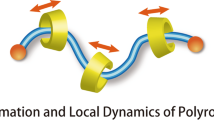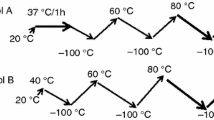Abstract
RADA 16-I is a synthetic amphiphilic peptide, composed of 16 amino acids, designed to self-assemble in a controlled way into fibrils and higher ordered structures depending on solvent condition. This peptide has many applications in tissue engineering and wound healing. We have studied the cluster formation of four RADA 16-I peptide chains in the presence of different concentrations of NaCl and CaCl2 as solvents, using all-atom molecular dynamics simulation. Nine independent simulations over 20 ns were performed. The results show that the fastest cluster formation rate occurs in the presence of 0.2 M NaCl following by water. In these simulations cluster formation doesn’t occur in the presence of CaCl2. It is also found that the cluster formation depends on two solvent-related factors: (a) salt concentration and (b) salt type. The effect of salts may act through changing the compactness and secondary structure of this peptide. In fact NaCl helps each peptide to adopt transitional expanded α-helical conformation in order to induce better interaction sites for self-assembly. The results gave insight into the effect of ionic strength in self-assembly mechanism of RADA 16-I in the bulk solution.








Similar content being viewed by others
References
G. M. Whitesides and M. Boncheva (2002). Proc. Natl. Acad. Sci. USA. 99, 4769.
S. Cavalli, F. Albericio, and A. Kros (2010). Chem. Soc. Rev. 39, 241.
S. Zhang (2002). Biotechnol. Adv. 20, 321.
D. Thirumalai, D. K. Klimov, and R. I. Dima (2003). Curr. Opin. Struct. Biol. 13, 146.
X. Zhao, F. Pan, and J. R. Lu (2010). Chem. Soc. Rev. 39, 3480.
R. G. Ellis-Behnke, Y. X. Liang, D. K. Tay, P. W. Kau, G. E. Schneider, S. Zhang, W. Wu, and K. F. So (2006). Nanotechnol Biol Med. 2, 207.
H. Yokoi, T. Kinoshita, and S. Zhang (2005). Proc. Natl. Acad. Sci. USA. 102, 8414.
F. Gelain, D. Bottai, and S. Zhang (2006). PLoS One. 1, e119.
M. Wu, Z. H. Yang, and X. Zhao (2010). J. Nanomater. 2010, 1.
J. Kisiday, M. Jin, and A. J. Grodzinsky (2002). Proc. Natl. Acad. Sci. USA. 99, 9996.
D. A. Narmoneva, O. Oni, and R. T. Lee (2005). Biomaterials. 26, 4837.
L. R. Robinson, N. C. Fitzgerald, and D. L. Bissett (2005). Int. J. Cosmet. Sci. 27, 155.
S. Y. Fung, H. Yang, and P. Chen (2008). PLoS One. 3, e1956.
S. Zhang, L. Yan, and A. Rich (1999). Biomaterials. 20, 1213.
J. P. Jung, J. Z. Gasiorowski, and J. H. Collier (2010). Biopolymers. 94, 49.
Y. Hong, L. S. Lau, R. L. Legge, and P. Chen (2004). J. Adhes. 80, 913.
Y. Hong, R. L. Legge, S. Zhang, and P. Chen (2003). Biomacromolecules. 4, 1433.
L. Piculell and S. Nilsson (1990). Prog. Colloid Polymer Sci. 82, 198.
E. B. Tu, G. Z. Ji, and X. K. Jiang (1997). Langmuir. 13, 4234.
O. V. Borisov and E. B. Zhulina (2002). Macromolecules. 35, 4472.
R. G. Ellis-Behnke, Y. X. Liang, S. W. You, D. K. Tay, S. Zhang, K. F. So, and G. E. Schneider (2006). Proc. Natl. Acad. Sci. USA. 103, 5054.
M. López De La Paz, K. Goldie, J. Zurdo, E. Lacroix, C. M. Dobson, A. Hoenger, and L. Serrano (2002). Proc. Natl. Acad. Sci. USA. 99, 16052.
T. J. Measey, R. Schweitzer-Stenner, V. Sa, and K. Kornev (2010). Macromolecules. 43, 7800.
B. Hess, C. Kutzner, D. van der Spoel, and E. Lindahl (2008). J. Chem. Theory Comput. 4, 435.
U. Essmann, L. Perera, M. L. Berkowitz, T. Darden, H. Lee, and L. G. Pedersen (1995). J. Chem. Phys. 103, 8577.
H. J. C. Berendsen, J. P. M. Postma, W. F. van Gunsteren, and J. Hermans (1981). Intermol Forces 14, 331.
W. Kabsch and C. Sander (1983). Biopolymers. 22, 2577.
W. Humphrey, A. Dalkeand, and K. Schulten (1996). VMD: visual molecular dynamics. J. Mol. Graph 14, 33.
S. Jun, Y. Hong, H. Imamura, B.-Y. Ha, J. Bechhoefer, and P. Chen (2004). Biophys. J. 87, 1249–1259.
Z. Ye, H. Zhang, H. Luo, S. Wang, Q. Zhou, X. DU, C. Tang, L. Chen, J. Liu, Y. K. Shi, E. Y. Zhang, R. Ellis-Behnke, and X. Zhao (2008). Pept. Sci. 14, 152.
M. Ghavami, M. Rezaeei, R. Ejtehadi, M. Lotfi, M. A. Shokrgoza, B. Abd Emamy, J. Raush, and M. Mahmoudi (2013). ACS Chem. Neurosci. 4, 375.
W. Hoyer, T. Antony, D. Cherny, G. Heim, T. M. Jovin, and V. Subramaniam (2002). J. Mol. Biol. 322, 383.
S. Zhang, T. Holmes, C. Lockshin, and A. Rich (1993). Proc. Natl. Acad. Sci. USA 90, (8), 3334.
J. R. Williamson, M. K. Raghuraman, and T. R. Cech (1989). cell 59, 871.
S. Jain and J. B. Udgaonkar (2010). Biochemistry. 49, (35), 7615.
Y. Hong, M. D. Pritzker, R. L. Legge, and P. Chen (2005). Colloids Surf B Biointerfaces 20, 152.
S. Zhang, C. Lockshin, A. Rich and T. Holmes (1997). US5670483 A.
P. Arosio, M. Owczarz, H. Wu, A. Butté, and M. Morbidelli (2012). Biophys. J. 102, (7), 1617.
C. N. Pace and J. M. Scholtz (1998). Biophys. J. 75, 422.
E. G. Hutchinson and J. M. Thornton (1994). Protein Sci. 3, 2207.
D. L. Minor and P. S. Kim (1994). Nature. 367, (6464), 660.
Z. Luo, B. Akerman, S. Zhang, and B. Norden (2010). Soft Matter. 6, 2260.
V. Azzarito, K. Long, N. S. Murphy, and A. J. Wilson (2013). Nat. Chem. 5, 161.
Author information
Authors and Affiliations
Corresponding author
Electronic Supplementary Material
Below is the link to the electronic supplementary material.
Rights and permissions
About this article
Cite this article
Aramvash, A., Seyedkarimi, M.S. All-Atom Molecular Dynamics Study of Four RADA 16-I Peptides: The Effects of Salts on Cluster Formation. J Clust Sci 26, 631–643 (2015). https://doi.org/10.1007/s10876-014-0836-8
Received:
Published:
Issue Date:
DOI: https://doi.org/10.1007/s10876-014-0836-8




